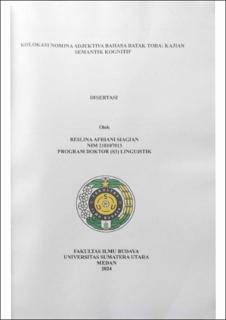Kolokasi Nomina Adjketiva Bahasa Batak Toba : Kajian Semantik Kognitif
Noun Adjective Collocation in Batak Toba Language: A Study of Cognitive Semantics

Date
2024Author
Siagian, Beslina Afriani
Advisor(s)
Mulyadi
Saragih, Amrin
Rangkuti, Rahmadsyah
Metadata
Show full item recordAbstract
Collocation is a language phenomenon that generally attracts the interest of researchers
in various subfields of linguistics, both theoretical and computational. So far, research
on collocations has only been based on various viewpoints from semantic studies, but has
not examined collocations from the perspective of the meaning relationship between
words. In fact, as part of linguistic elements, the form and meaning of collocations are
manifestations of conceptual structure, which represents human cognitive abilities. For
this reason, this research examines the collocation of adjective nouns in the Batak Toba
language using cognitive semantic studies. This research answers five problem
formulations, namely patterns, categorization of adjective nouns, differences in semantic
types of adjectives, formation and meaning of collocations, and speakers' understanding
regarding collocations of adjective nouns in the Batak Toba language. This research uses
a qualitative approach by utilizing various data, such as written data, oral data, and also
questionnaires, both as primary data and secondary data. Data collection was carried
out using the listening method and skill method, while data analysis was carried out using
the matching method and distributional method. Based on various research stages, the
following results were found. First, the noun adjective collocation patterns found in the
Batak Toba language include, 1) noun + adjective pattern, 2) noun + na + adjective
pattern, 3) noun + na + so + adjective pattern, and 4) noun + na + so + ra + adjective
pattern. The collocation pattern of adjective nouns in the Batak Toba language also tends
to be characterized by metaphors in the nouns as the lexical core. Second, collocation
categorization is found in three categories, namely: 1) category A which is formed
through the collocation of nouns which have the semantic characteristic [+CONCRETE]
with adjectives which have the semantic characteristic [+DIMENSION, +COLOR,
+VALUE, +AGE, +SPEED] , 2) category B which is formed through the collocation of
a noun which has the semantic characteristic [+LIVING] with an adjective which has the
semantic characteristic [+DIMENSION, +COLOR, +VALUE, +AGE, +SPEED], c)
category C which is formed through the collocation of the noun which has the semantic
characteristics of [+INSANI] with adjectives that have the semantic characteristics of all
adjectives. Third, differences in the semantic types of adjectives using the synonymy test
reveal how Batak Toba speakers' cognition is in juxtaposing two words into a collocation.
In fact, two words that are considered similar (synonyms) have nuances in meaning that
mean that not all adjectives can be compared with the same noun. Fourth, the formation
and meaning of collocations using constructional schemes, frames and conceptual
combinations found that Batak Toba language speakers have excellent cognitive abilities
in describing meaning through word pairings (collocations). Uniquely, the pairing of
words is obtained through the objects around them which makes these collocations easier
to understand and use in everyday communication. Finally, the understanding of Batak
Toba language speakers obtained using a speaker questionnaire shows the same meaning
as the meaning obtained using cognitive semantic studies. For this reason, further
research is needed in the form of the formation and meaning of Toba Batak language
collocations as a basis for creating a Batak Toba language collocation dictionary.
